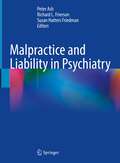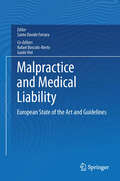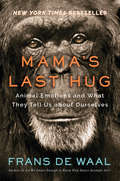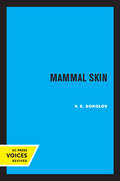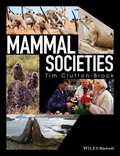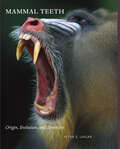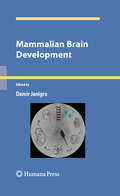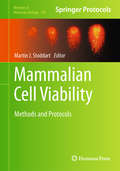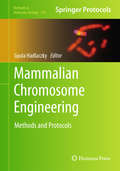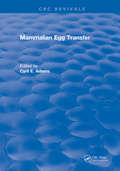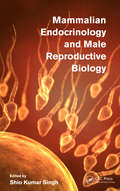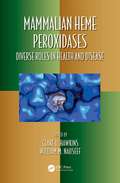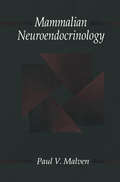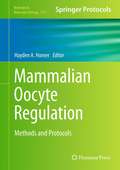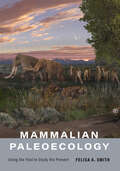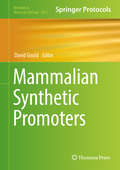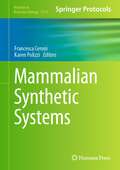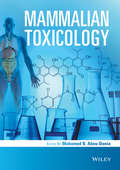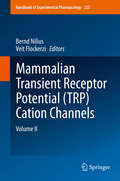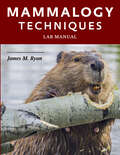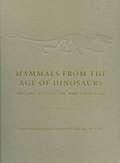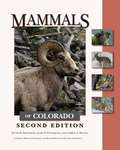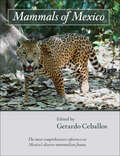- Table View
- List View
Malpractice and Liability in Psychiatry
by Peter Ash Richard L. Frierson Susan Hatters FriedmanThis book comprehensively educates psychiatrists about malpractice and other liability. It is written to also specifically assist psychiatrists who are sued or are involved in other complaints. The first two sections discuss malpractice law and the litigation process; the litigation section mainly addresses some of the more emotionally charged issues, including do’s and don’ts, how an attorney will be looking at the case, the defendant doctor’s testifying at deposition and trial, and the stress of being sued. The subsequent three sections address specific topics that give rise to liability, with each section taking a different perspective such as risks in particular clinical, by practice site, and special issues, including practice in special situations such as the current pandemic. The final section discusses other forms of liability, such as complaints to medical boards or professional association ethics committees. An exceptional work, Malpractice and Liability in Psychiatry, functions as both a go-to handbook and all-encompassing read on the aforementioned topics.
Malpractice and Medical Liability
by Guido Viel Rafael Boscolo-Berto Santo Davide FerraraMedical responsibility lawsuits have become a fact of life in every physician's medical practice. However, there is evidence that physicians are increasingly practising defensive medicine, ordering more tests than may be necessary and avoiding patients with complicated conditions. The modern practice of medicine is increasingly complicated by factors beyond the traditional realm of patient care, including novel technologies, loss of physician autonomy, and economic pressures. A continuing and significant issue affecting physicians and the healthcare system is malpractice. In the latter half of the 20th century, there was a major change in the attitude of the public towards the medical profession. People were made aware of the huge advances in medical technology, because health problems increasingly tended to attract media interest and wide publicity. Medicine is a victim of its own success in this respect, and people are now led to expect the latest techniques and perfect outcomes on all occasions. This burst of technology and hyper-specialization in many fields of medicine means that each malpractice claim is transformed into a scientific challenge, requiring specific preparation in analysis and judgment of the clinical case in question. The role of legal medicine becomes more and more peculiar in this judicial setting, often giving rise to erroneous interpretations and hasty scientific verdicts, but guidelines on the methodology of ascertainments and criteria of evaluation are lacking all over the world.The aim of this volume is to clarify the steps required for sequential in-depth analysis of events and consequences of medical actions, in order to verify whether, in the presence of damage, errors or non-observance of rules of conduct by health personnel exist, and which causal values and links of their hypothetical misconduct are involved.
Mama's Last Hug: Animal Emotions And What They Tell Us About Ourselves
by Frans De WaalNew York Times best-selling author and primatologist Frans de Waal explores the fascinating world of animal and human emotions. <P><P> Frans de Waal has spent four decades at the forefront of animal research. Following up on the best-selling Are We Smart Enough to Know How Smart Animals Are?, which investigated animal intelligence, Mama’s Last Hug delivers a fascinating exploration of the rich emotional lives of animals. <P><P> Mama’s Last Hug begins with the death of Mama, a chimpanzee matriarch who formed a deep bond with biologist Jan van Hooff. When Mama was dying, van Hooff took the unusual step of visiting her in her night cage for a last hug. Their goodbyes were filmed and went viral. Millions of people were deeply moved by the way Mama embraced the professor, welcoming him with a big smile while reassuring him by patting his neck, in a gesture often considered typically human but that is in fact common to all primates. This story and others like it form the core of de Waal’s argument, showing that humans are not the only species with the capacity for love, hate, fear, shame, guilt, joy, disgust, and empathy. <P><P> De Waal discusses facial expressions, the emotions behind human politics, the illusion of free will, animal sentience, and, of course, Mama’s life and death. The message is one of continuity between us and other species, such as the radical proposal that emotions are like organs: we don’t have a single organ that other animals don’t have, and the same is true for our emotions. Mama’s Last Hug opens our hearts and minds to the many ways in which humans and other animals are connected, transforming how we view the living world around us. <P><b>A New York Times Bestseller</b>
Mammal Skin (Comparative Studies of Health Systems and Medical Care #37)
by V.E. SokolovThis title is part of UC Press's Voices Revived program, which commemorates University of California Press’s mission to seek out and cultivate the brightest minds and give them voice, reach, and impact. Drawing on a backlist dating to 1893, Voices Revived makes high-quality, peer-reviewed scholarship accessible once again using print-on-demand technology. This title was originally published in 1982.
Mammal Societies
by Tim Clutton-BrockThe book aims to integrate our understanding of mammalian societies into a novel synthesis that is relevant to behavioural ecologists, ecologists, and anthropologists. It adopts a coherent structure that deals initially with the characteristics and strategies of females, before covering those of males, cooperative societies and hominid societies. It reviews our current understanding both of the structure of societies and of the strategies of individuals; it combines coverage of relevant areas of theory with coverage of interspecific comparisons, intraspecific comparisons and experiments; it explores both evolutionary causes of different traits and their ecological consequences; and it integrates research on different groups of mammals with research on primates and humans and attempts to put research on human societies into a broader perspective.
Mammal Teeth: Origin, Evolution, and Diversity
by Peter S. UngarWinner, 2010 PROSE Award for Excellence in the Biological Sciences. Professional and Scholarly Publishing division of the Association of American PublishersIn this unique book, Peter S. Ungar tells the story of mammalian teeth from their origin through their evolution to their current diversity.Mammal Teeth traces the evolutionary history of teeth, beginning with the very first mineralized vertebrate structures half a billion years ago. Ungar describes how the simple conical tooth of early vertebrates became the molars, incisors, and other forms we see in mammals today. Evolutionary adaptations changed pointy teeth into flatter ones, with specialized shapes designed to complement the corresponding jaw. Ungar explains tooth structure and function in the context of nutritional needs. The myriad tooth shapes produced by evolution offer different solutions to the fundamental problem of how to squeeze as many nutrients as possible out of foods. The book also highlights Ungar's own path-breaking studies that show how microwear analysis can help us understand ancient diets.The final part of the book provides an in-depth examination of mammalian teeth today, surveying all orders in the class, family by family. Ungar describes some of the more bizarre teeth, such as tusks, and the mammal diversity that accompanies these morphological wonders. Mammal Teeth captures the evolution of mammals, including humans, through the prism of dental change. Synthesizing decades of research, Ungar reveals the interconnections among mammal diet, dentition, and evolution. His book is a must-read for paleontologists, mammalogists, and anthropologists.
Mammalian Brain Development
by Damir JanigroThis book fills a gap in developmental books dealing with the normal prenatal mammalian brain. Most books that approach this topic work with non-human, non-vertebrate models. Mammalian Brain Development focuses on both the pre-natal and the peri-natal events that lead to brain damage as seen in the prospective of medical and research professionals, as well as examining the traditional "nature versus nurture" argument in the spectrum of brain development. The major topics addressed, in detail, in the book are sexual dimorphism, epigenetic action of gonadal hormones, environmental "programming" effects, autism, developmental learning disorders, seizures, and the etiopathogenesis of epileptic syndromes in young humans. The book also covers the general aspects of postnatal and pediatric neurological disorders in a unique and novel way by offering definitions of heredity, inheritance, genetic-epigenetic, genomic, molecular, developmental, and innate aspects of the mammalian brain in regards to its development.
Mammalian Cell Cultures for Biologics Manufacturing
by Weichang Zhou Anne KantardjieffVolumes are organized topically and provide a comprehensive discussion of developments in the respective field over the past 3-5 years. The series also discusses new discoveries and applications. Special volumes are dedicated to selected topics which focus on new biotechnological products and new processes for their synthesis and purification. In general, special volumes are edited by well-known guest editors. The series editor and publisher will however always be pleased to receive suggestions and supplementary information. Manuscripts are accepted in English.
Mammalian Cell Viability
by Martin J. StoddartWhether the question is one of basic cell survival, or whether it is being used to correlate cell number to some other factor such as matrix synthesis, an estimate of cell viability is universally required. In Mammalian Cell Viability: Methods and Protocols, experts in the field describe methods from the most basic which can be performed in any laboratory, to some which require specific pieces of equipment. Initially focusing on methods for monolayer and suspension cells, later chapters describe methods for determining viability within tissue sections and 3 dimensional culture systems. Finally, methods requiring highly specialized equipment are described in order to explain what is possible. Written in the highly successful Methods in Molecular BiologyTM series format, chapters include introductions to their respective topics, lists of the necessary materials and reagents, step-by-step, readily reproducible laboratory protocols, and vital tips on troubleshooting and avoiding known pitfalls. Practical and adaptable, Mammalian Cell Viability: Methods and Protocols serves as a self-contained laboratory manual useful to both experienced researchers and those new to this incredibly important and influential field.
Mammalian Chromosome Engineering
by Gyula HadlaczkyThe rapid progression of genetics and molecular biology has turned chromosomal engineering from science fiction to reality, with the successful production of transgenic animals with engineered chromosomes and chromosomes developed for pharmaceutical protein production which are now ready for the medical industry. Mammalian Chromosome Engineering: Methods and Protocols provides the reader with up-to date information on this rapidly evolving field and strives to take the reader into the exciting realm of chromosomal engineering from the basic principles to the practical applications of these new technologies. The five overview and ten protocol chapters cover the engineering of chromosomes with extrachromosomal vectors and transposon systems, the manipulation of naturally occurred minichromosomes, the generation and engineering of synthetic artificial chromosomes, and the induced de novo platform artificial chromosome system. Written in the highly successful Methods in Molecular BiologyTM series format, protocols chapters contain brief introductions to their respective topics, lists of the necessary materials and reagents, step-by-step, readily reproducible laboratory protocols, and tips on troubleshooting and avoiding known pitfalls. Authoritative and cutting-edge, Mammalian Chromosome Engineering: Methods and Protocols serves as a bench-side resource for current protocols and aims to help scientists to explore the many prospects for future research and vital applications.
Mammalian Egg Transfer
by Lewis AdamsEgg transfer was first performed in 1890, but for half a century it received scant attention. However, since 1950 the technique has become increasingly widely used - in the laboratory for fundamental studies and more recently in practice, both veterinary and medical, to boost reproductive potential of genetically superior cattle and to overcome sterility due to impaired rubal function in women. As a result, a considerable body of literature has accumulated, totaling well in excess of a thousand references. But till now there has not been a single comprehensive text devoted solely to this subject. The present work was designed to meet that need at a time when the field is fast expanding with new techniques and approaches constantly being evolved. One need only cite the tremendous rate of progress in human egg transfer in the last three years. The work embraces laboratory and farm animals and primates, including man, altogether representing a total of 16 species.
Mammalian Endocrinology and Male Reproductive Biology
by Shio Kumar SinghMammalian Endocrinology and Male Reproductive Biology provides comprehensive and current coverage of the area of endocrinology and male reproductive biology, covering not just humans, but mammals in general. Written by international experts in their respective fields, this multi-author book also covers the latest developments in genomics of androge
Mammalian Heme Peroxidases: Diverse Roles in Health and Disease (Oxidative Stress and Disease #47)
by Clare L. HawkinsMammalian heme peroxidase enzymes play a critical role in innate immune responses and disease prevention. The formation of potent chemical oxidants is essential to this protective physiologic activity in immunity. Although highly beneficial in the context of immune defense, it is now well established that peroxidases and their overproduction of oxidants contribute to the initiation and persistence of many chronic inflammatory conditions in the cardiovascular, neurologic, respiratory, renal, and gastrointestinal systems. Peroxidasins, a protein family related to heme peroxidases, play a novel role in tissue biogenesis and matrix assembly, which are also attracting attention in different pathological contexts. Given the diverse roles of mammalian heme peroxidases and the breadth and incidence of pathologies associated with these enzymes, there has been significant interest in modulating peroxidase activity as a therapeutic strategy. This book highlights recent developments in our understanding of the chemistry, biochemistry and biological roles of mammalian peroxidases and their associated oxidants, their involvement in both innate immunity and chronic inflammatory disease in a variety of end organs, and potential therapeutic approaches to modulate and prevent damaging reactions. Key Features Structure and biosynthesis of mammalian peroxidases Reactivity of hypohalous acids with biological substrates Peroxidases in innate immunity Peroxidases in human pathology Modulation of peroxidase-induced biological damage
Mammalian Neuroendocrinology
by Paul V. MalvenMammalian Neuroendocrinology presents a concise examination of how the nervous and endocrine systems interact to regulate physiological processes. Selected experimental results are presented to illustrate the current understanding of neuroendocrine processes. Neural influences and endocrine feedback mechanisms related to the secretion of adenohypophysial hormones are summarized for each hormone. The book's concise nature and readable style are highly suited for use as a graduate textbook.There are also chapters devoted to each of the following topics: neurohypophysis, pineal gland, adrenal medulla, hormones and behavior, and neuroendocrine immunology. Comparisons are made among species of mammals, including laboratory rodents, domesticated ungulates, and primates. Agricultural and/or clinical aspects relevant to these topics are covered when appropriate. Mammalian Neuroendocrinology is excellent for students and professionals in neuroendocrinology, neuroscience, endocrinology, reproduction studies, and animal sciences.
Mammalian Oocyte Regulation
by Hayden A. HomerMammalian oocytes occupy a critical nexus in reproduction as they not only contribute half the genetic makeup of the embryo but also provide virtually all of the cytoplasmic building blocks required for sustaining embryogenesis. The journey that transforms a primordial germ cell into a mature oocyte (or egg) capable of fertilisation and embryonic development is of unrivalled complexity. The end-product of this remarkable developmental process is the "mature" egg, now replete with macromolecules and organelles, and poised to support embryonic development if fertilisation should occur. Given the importance of the oocyte for embryonic development, it is of no surprise that the oocyte holds centre stage in fertility clinics and greatly influences the outcome of assisted reproductive treatments (ARTs). Mammalian Oocyte Regulation: Methods and Protocols provides a highly diverse compendium of detailed methodologies - primarily focusing on the murine model but also including chapters on human oocytes - for enabling researchers to interrogate every aspect of mammalian oocyte development including recombination, meiotic maturation, oocyte substrate uptake, chromosomal segregation and fertilisation. Written in the highly successful Methods in Molecular BiologyTM series format, chapters contain introductions to their respective topics, lists of the necessary materials and reagents, step-by-step, readily reproducible laboratory protocols, and notes on troubleshooting and avoiding known pitfalls. Authoritative and easily accessible, Mammalian Oocyte Regulation: Methods and Protocols serves as an ideal guide to novice oocyte researchers, experts who wish to add another dimension to their established portfolio, as well as the wider research community.
Mammalian Paleoecology: Using the Past to Study the Present
by Felisa A. SmithWhat can the interactions of ancient mammals and their environments tell us about the present—and the future?Classic paleontology has focused on the study of fossils and the reconstruction of lineages of extinct species. But as diverse fossils of animals and plants were unearthed and catalogued, it became possible to reconstruct more elaborate ecosystems, tying together plants, animals, and geology. By the second half of the twentieth century, this effort gave birth to the field of paleoecology: the study of the interactions between organisms and their environments across geologic timescales. In Mammalian Paleoecology, Felisa Smith broadly considers extinct mammals in an ecological context. Arguing that the past has much to teach us and that mammals, which display an impressive array of diverse life history and ecological characteristics, are the ideal organism through which to view the fossil record, Smith• reviews the history, major fossil-hunting figures, and fundamental principles of paleoecology, including stratigraphy, dating, and taphonomy• discusses the importance of mammal body size, how to estimate size, and what size and shape reveal about long-dead organisms• explains the structure, function, and utility of different types of mammal teeth• highlights other important methods and proxies used in modern paleoecology, including stable isotopes, ancient DNA, and paleomidden analyses• assesses nontraditional fossils• presents readers with several case studies that describe how the fossil record can help inform the scientific discussion on anthropogenic climate changeMammalian Paleoecology is an approachable overview of how we obtain information from fossils and what this information can tell us about the environments of the distant past. It will profoundly affect the way paleontologists and climatologists view the lives of ancient mammals.
Mammalian Sterols: Novel Biological Roles of Cholesterol Synthesis Intermediates, Oxysterols and Bile Acids
by Damjana Rozman Rolf GebhardtThis book provides a comprehensive description of sterols and their novel biological roles in mammalian signaling, the book covers their biosynthesis and structure, describes sterol receptor -mediated actions, their tissue distribution and their role in disease. It offers insight into new research findings, focusing specifically on novel discoveries in bile acid and oxysterol signaling, including the lanosterol-to-cholesterol intermediates. Special attention is paid on the sex distribution of these sterols (male or female) and their sexually dimorphic roles in mammalian species, such as human, rat and mouse. Since sterols and drugs (xenobiotics) use many identical receptor-mediated signaling pathways, the book will be interesting for researchers working on the cross-road of endogenous and xenobiotic metabolism, it is intended for advanced students and scientists in molecular biology and biochemistry as well as for medical doctors in hepatology.
Mammalian Synthetic Promoters (Methods in Molecular Biology #1651)
by David GouldThis volume details methods that will aid in the selection of promoter sequences and vector components and methods for the assembly and testing of synthetic promoters with examples of their application. Written in the highly successful Methods in Molecular Biology series format, chapters include introductions to their respective topics, lists of the necessary materials and reagents, step-by-step, readily reproducible laboratory protocols, and tips on troubleshooting and avoiding known pitfalls. Authoritative and cutting-edge, Mammalian Synthetic Promoters: Methods and Protocols aims to aid researchers that are new to the field of synthetic promoters and inspire new developments.
Mammalian Synthetic Systems (Methods in Molecular Biology #2774)
by Francesca Ceroni Karen PolizziThis volume details cutting-edge methods that enables engineering of novel functions in mammalian cells. Chapters guide readers through cell-to-cell communication, cell fate control, protein and RNA-based biosensors together with tools for more reliable and faster mammalian genome editing. Written in the highly successful Methods in Molecular Biology series format, chapters include introductions to their respective topics, lists of the necessary materials and reagents, step-by-step, readily reproducible laboratory protocols, and key tips on troubleshooting and avoiding known pitfalls. Authoritative and cutting-edge, Mammalian Synthetic Systems aims to ensure successful results in the further study of this vital field.
Mammalian Toxicology
by Mohamed Abou-DoniaMammalian Toxicology surveys chemical agents and examineshow such chemicals impact on human health, emphasizing theimportance in minimizing environmental exposure to chemical andphysical hazards in our homes, communities and workplaces throughsuch media as contaminated water, soil and air.Starting with the basic principles on a wide range of toxicagents, this textbook describes how they enter the body, theirmechanisms of action once inside, and strategies for diagnosis,prevention and treatment.Topics covered include:General principles of toxicology: pharmacological andtoxicological principles underpinning the study of toxicology, risk assessments and mechanisms of cell deathDisposition: routes of chemical exposures, entry intothe body and various tissues, storage, metabolic biotransformationand elimination, with examples from various toxicants.Toxic agents: the occurrences, disposition in the body,health effects, toxic mechanisms, antidotes and treatments of arange of agents including pesticides, metals, solvents, gases,nanomaterials, food components and additives, pharmaceuticals,drugs of abuse, natural toxins, endocrine disruptors, radiation,and warfare weapons. Toxic effects: including neurotoxicity, developmentaltoxicity, immunotoxicity, teratogenecity, male and femalereproductive toxicity, mutagenecity, carcinogenicity, pulmonary toxicity, cardiovascular toxicity, hepatotoxicity,gastrointestinal toxicity and cardiovascular toxicityToxicology and society: epidemiological studies ofchemical-induced diseases in human populations, and a vision fortoxicology in the 21st century.Mammalian Toxicology is an essential primer for studentsof toxicology, biochemistry, biology, medicine and chemistry. It isalso appropriate for professional toxicologists in research orregulatory affairs, and anyone who needs to understand the adverseeffects of toxic agents on the human body.
Mammalian Transient Receptor Potential (TRP) Cation Channels
by Bernd Nilius Veit FlockerziIn this fast moving field the main goal of this volume is to provide up-to-date information on the molecular and functional properties and pharmacology of mammalian TRP channels. Leading experts in the field will describe properties of a single TRP protein/channel or portray more general principles of TRP function and important pathological situations linked to mutations of TRP genes or their altered expression. Thereby this volume on Transient Receptor Potential (TRP) Channels provides valuable information for readers with different expectations and backgrounds, for those who are approaching this field of research as well as for those wanting to make a trip to TRPs.
Mammalogy Techniques Lab Manual
by James M. RyanGet outside! A hands-on lab manual for instructors incorporating fieldwork into their courses on mammalogy.Mammals inhabit nearly every continent and every sea. They have adapted to life underground, in the frozen Arctic, the hottest deserts, and every habitat in-between. In Mammalogy Techniques Lab Manual—the only field manual devoted to training the next generation of mammalogists—biologist and educator James M. Ryan details the modern research techniques today’s professionals use to study mammals wherever they are found.Ideal for any mammalogy or wildlife biology course, this clear and practical guide aids students by getting them outside to study mammals in their natural environments. Twenty comprehensive chapters cover skull and tooth identification, radio and satellite GPS tracking, phylogeny construction, mark and recapture techniques, camera trapping, museum specimen preparation, optimal foraging, and DNA extraction, among other topics. Each chapter includes several exercises with step-by-step instructions for students to collect and analyze their own data, along with background information, downloadable sample data sets (to use when it is not practical to be out in the field), and detailed descriptions of useful open-source software tools.This pragmatic resource provides students with real-world experience practicing the complex techniques used by modern wildlife biologists. With more than 60 applied exercises to choose from in this unique manual, students will quickly acquire the scientific skills essential for a career working with mammals.
Mammals from the Age of Dinosaurs: Origins, Evolution, and Structure
by Zofia Kielan-Jaworowska Zhe-Xi Luo Richard CifelliThe fossil record on Mesozoic mammals has expanded by orders of magnitude over the past quarter century. New specimens, some of them breathtakingly complete, have been found in nearly all parts of the globe at a rapid pace. Coupled with the application of new scientific approaches and techniques, these exciting discoveries have led to profound changes in our interpretation of early mammal history. Mesozoic mammals have come into their own as a rich source of information for evolutionary biology. Their record of episodic, successive radiations speaks to the pace and mode of evolution. Early mammals were small, but they provide key information on the morphological transformations that led to modern mammals, including our own lineage of Placentalia. Significant and fast-evolving elements of the terrestrial biota for much of the Mesozoic, early mammals have played an increasingly important role in studies of paleoecology, faunal turnover, and historical biogeography. The record of early mammals occupies center stage for testing molecular evolutionary hypotheses on the timing and sequence of mammalian radiations. Organized according to phylogeny, this book covers all aspects of the anatomy, paleobiology, and systematics of all early mammalian groups, in addition to the extant mammalian lineages extending back into the Mesozoic.
Mammals of Colorado, Second Edition
by David M. Armstrong James P. Fitzgerald Carron A. MeaneyCo-published with the Denver Museum of Nature & Science. Thoroughly revised and updated, Mammals of Colorado, Second Edition is a comprehensive reference on the nine orders and 128 species of Colorado's recent native fauna, detailing each species' description, habitat, distribution, population ecology, diet and foraging, predators and parasites, behavior, reproduction and development, and population status. An introductory chapter on Colorado's environments, a discussion of the development of the fauna over geologic time, and a brief history of human knowledge of Coloradan mammals provide ecological and evolutionary context. The most recent records of the state's diverse species, rich illustrations (including detailed maps, skull drawings, and photographs), and an extensive bibliography make this book a must-have reference. Amateur and professional naturalists, students, vertebrate biologists, and ecologists as well as those involved in conservation and wildlife management in Colorado will find value in this comprehensive volume.
Mammals of Mexico
by Gerardo CeballosThe most comprehensive reference on Mexico's diverse mammalian fauna.Mammals of Mexico is the first reference book in English on the more than 500 types of mammal species found in the diverse Mexican habitats, which range from the Sonoran Desert to the Chiapas cloud forests. The authoritative species accounts are written by a Who’s Who of experts compiled by famed mammalogist and conservationist Gerardo Ceballos.Ten years in the making, Mammals of Mexico covers everything from obscure rodents to whales, bats, primates, and wolves. It is thoroughly illustrated with color photographs and meticulous artistic renderings, as well as range maps for each species. Introductory chapters discuss biogeography, conservation, and evolution. The final section of the book illustrates the skulls, jaws, and tracks of Mexico’s mammals. This unparalleled collection of scientific information on, and photographs of, Mexican wildlife belongs on the shelf of every mammalogist, in public and academic libraries, and in the hands of anyone curious about Mexico and its wildlife.
